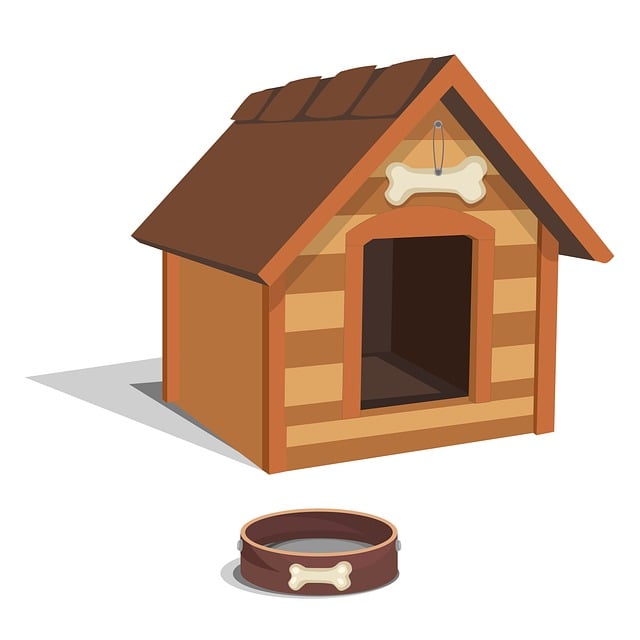This text explores built-in heating systems, their technologies (electric, hydronic, forced air furnaces), and their applications beyond homes, highlighting a growing trend: heated dog houses. It explains why pet owners are demanding these solutions for pet comfort in colder months. The overview delves into system types, installation for DIYers, maintenance tips, and energy efficiency benefits. Key takeaways include the rise of heated dog houses as a pet welfare solution, future innovations focusing on sustainability and smart home integration, and the cost-saving, eco-friendly advantages of built-in heating systems compared to traditional methods.
“Discover the warmth and comfort of built-in heating systems for heated dog houses, a growing trend among pet owners. This comprehensive guide explores various aspects, from understanding the technology to choosing the right system, installation, maintenance, and energy efficiency. Learn why these heated dog houses are in demand and how they enhance pet welfare. We’ll also delve into future trends, offering valuable insights for pet lovers seeking innovative solutions.”
Understanding Built-In Heating Systems: A Comprehensive Overview

Built-in heating systems are designed to seamlessly integrate into various spaces, providing efficient and comfortable warmth. These systems go beyond traditional heaters by offering discreet yet powerful solutions for both residential and commercial settings. One notable application is the heated dog house, showcasing how built-in heating can enhance comfort for pets as well.
Understanding these systems involves grasping their diverse technologies, including electric heating elements, hydronic radiators, and forced air furnaces. Each method has its advantages, catering to different needs and preferences. For instance, electric heating offers ease of installation but may require more frequent maintenance, while hydronic systems provide even heat distribution and are known for their longevity. This comprehensive overview aims to demystify built-in heating, empowering informed decisions for those seeking optimal indoor comfort, whether it’s a cozy home or a specialized heated dog house.
The Demand for Heated Dog Houses and Why It Matters

In recent years, there has been a notable rise in demand for heated dog houses among pet owners. This trend reflects a growing understanding of the importance of comfort and well-being for our furry friends, especially during colder months. Just as humans seek warmth and shelter when temperatures drop, dogs too require suitable accommodation to stay healthy and happy. A heated dog house provides insulation from harsh weather conditions, preventing hypothermia and ensuring your pet can relax outdoors without discomfort.
This demand is driven by a combination of factors. Pet parents want to offer their canine companions the best care possible, recognizing that outdoor activities should not be limited by frosty temperatures. Additionally, many dog breeds are naturally adapted to colder climates but still need protection from extreme cold snaps. Heated dog houses enable owners to maintain their pets’ quality of life, allowing them to enjoy outdoor playtime and exploration regardless of seasonal changes.
Types of Heating Technologies Used in Built-In Systems

Built-in heating systems offer a range of technologies designed to efficiently heat spaces, including homes and even heated dog houses. One common type is electric heating, which utilizes resistive elements to generate heat. These systems are known for their ease of installation and quiet operation, making them popular for both residential and commercial applications. Another advanced option is hydronic heating, which circulates hot water or heating fluid through pipes embedded in floors, walls, or ceilings, providing even and consistent warmth.
For a more eco-friendly approach, heat pump systems have gained popularity. These devices transfer heat from the outdoor air (or ground) to the indoor space, offering energy efficiency and cost savings. Additionally, some built-in heating systems incorporate smart controls and thermostats, allowing users to precisely regulate temperature settings and optimize energy use, ensuring comfort while minimizing energy consumption.
Factors to Consider When Choosing a Heated Dog House System

When choosing a built-in heating system for your dog’s house, several factors come into play to ensure your pet stays cozy and comfortable all year round. Firstly, consider the climate you live in; if you reside in an area with extreme cold, a more robust and efficient heating system will be required compared to milder climates. The size of your dog house is also crucial; larger spaces need higher heat output to maintain a consistent temperature. Look for systems that offer adjustable settings to control the warmth according to seasonal changes and your dog’s needs.
Another important consideration is energy efficiency, especially if you want to keep costs down. Some models come with advanced features like thermostats and automatic shut-off mechanisms to prevent overheating. Additionally, checking the type of heating element used can impact performance and safety; ceramic or metal elements are common choices known for their durability and even heat distribution. Always ensure the system is pet-safe and meets industry standards to guarantee a secure environment for your furry friend.
Installation Process: Step-by-Step Guide for DIY Enthusiasts

For DIY enthusiasts looking to create a cozy heated dog house, installation is an exciting step. Here’s a simplified guide to help you navigate the process:
1. Plan and Measure: Start by measuring your dog’s size and needs. Then, design or choose a plan that suits their dimensions. Ensure the heated space allows for comfortable movement and includes insulation for warmth retention.
2. Gather Materials: Based on your chosen design, assemble materials including wood for construction, heating elements (like heating pads or cables), insulation, and a thermostat to control temperature. Don’t forget safety gear like gloves and goggles.
3. Build the Structure: Construct the dog house framework using your measured plans. Ensure structural integrity by following proper building techniques. Consider adding doors for easy access and ventilation, which can be crucial in warmer months.
4. Install Heating System: Position heating elements safely within the dog house, ensuring they are protected from chewing or contact with fur. Connect them to a power source and install the thermostat to set desired temperatures. Test the system to ensure even heating across all areas.
5. Insulate: Fill the dog house with insulation material to trap heat and keep your pet warm during cold nights. Pay special attention to sealing gaps to prevent heat loss.
Maintenance Tips to Ensure Optimal Performance

To keep your heated dog house running smoothly, regular maintenance is key. Start by checking the heating element for any signs of damage or corrosion every few months. Clean or replace it as needed to maintain efficient heat distribution. Additionally, inspect the insulation to ensure it’s secure and in good condition; damaged insulation can cause heat loss.
Regular cleaning of the unit is essential too. Use a vacuum to remove dust and debris from all accessible areas, including vents and grilles. This simple step prevents blockages and ensures optimal airflow, maintaining a comfortable temperature for your furry friend. Remember, consistent care will not only extend the lifespan of your built-in heating system but also guarantee its effectiveness in keeping your dog house warm and cozy.
Energy Efficiency and Cost Savings with Built-In Heating

Built-in heating systems in homes, including those designed for pets like heated dog houses, offer significant energy efficiency and cost savings. Unlike traditional heating methods that rely on external units and can waste a considerable amount of energy, built-in systems are integrated directly into the structure. This ensures consistent and targeted warmth, eliminating heat loss through gaps or poor insulation. As a result, homeowners and pet owners alike can enjoy reduced utility bills while contributing less to environmental impact.
The efficiency of these systems stems from their ability to distribute heat evenly throughout the space they cover. By utilizing advanced technologies like smart thermostats and zone control, users can program temperatures according to specific needs, preventing unnecessary heating in unoccupied areas. This precision heating not only conserves energy but also creates a more comfortable environment for both inhabitants and pets, making heated dog houses an excellent example of modern, eco-conscious living.
Case Studies: Real-World Applications of Heated Dog Houses

In recent years, there has been a growing interest in heated dog houses as a comfortable and safe solution for outdoor pets. Case studies across various regions have demonstrated the real-world applications and benefits of such systems. For instance, in colder climates, homeowners have implemented built-in heating systems in their doghouses to ensure year-round comfort for their furry friends. These systems use efficient heating elements that maintain optimal temperatures, protecting dogs from harsh winter conditions without compromising on ventilation.
One notable example is a study conducted in Canada, where a heated dog house was installed in a rural area. The system utilized a combination of underfloor heating and a small, quiet fan to distribute warm air evenly. This setup not only provided warmth during icy winters but also helped keep the interior dry and comfortable, reducing the risk of respiratory issues for the dog. These heated dog houses have become popular among pet owners, showcasing the practical application of built-in heating technology in enhancing pet welfare.
Future Trends in Pet Housing and Heating Technology

With the ever-evolving technology in pet housing, the future looks bright for keeping our furry friends cozy and comfortable all year round. One exciting trend is the integration of advanced heating systems into pet shelters and dog houses. Heated dog houses are no longer a luxury but an essential consideration for pet owners living in colder climates. These innovative designs utilize smart thermostats and temperature sensors to maintain optimal warmth, ensuring pets stay toasty during winter months without compromising their well-being.
Looking ahead, sustainability and energy efficiency will play a significant role in shaping pet housing technology. Heated dog houses equipped with solar panels or eco-friendly heating elements could become commonplace, promoting environmental consciousness while providing consistent comfort for our beloved pets. Additionally, smart home integration might allow owners to control and monitor their pet’s living conditions remotely, further enhancing the overall convenience and peace of mind.
